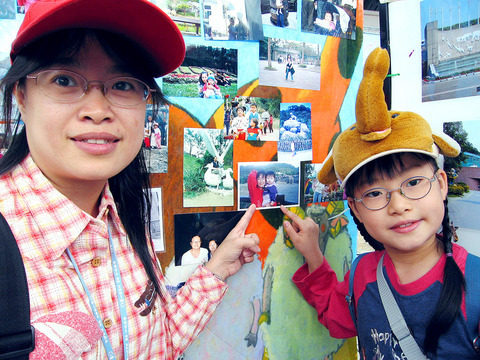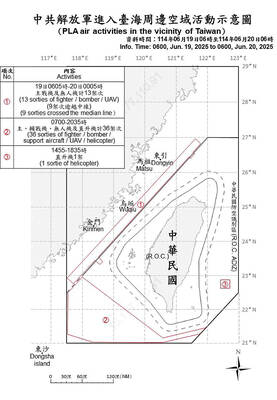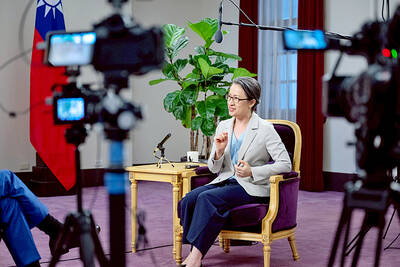Taipei Zoo yesterday celebrated the 20th anniversary of its relocation to its current premises.
The zoo moved from Yuanshan in Shilin District to Muzha, Wen-shan District, in 1986.
Visitors were entertained by various activities, including quizzes on conservation, displays of Taiwanese wildlife and habitat, free photos of animals and outdoor music concerts.

PHOTO: LIN HSIANG-MEI, TAIPEI TIMES
A 46cm tall cake was on display for the event, and 800 small cakes were distributed to visitors.
Over the years, the zoo has evolved from a showcase where animals were put on display with little regard for their condition into a center for research and education, as well as a place where wild animals are housed in increasingly natural and humane surroundings, zoo Deputy Director Yang Chien-Jen (
The zoo has also undertaken a number of on and off-site research activities, he said.
"We sent a five-person contingent to Green Island, who found fruit bats [that were] thought to be extinct," Yang said. "We've also done a lot of research on the Formosan black bear, including observing previously unknown behavioral patterns and helping universities analyze bear droppings for stress hormones in our in-house lab."
The zoo was not quite so animal-friendly in the old days, 20-year veteran volunteer Wang Hu-cheng (
"The animals were treated purely as exhibits," he said, recalling how things were in the zoo's old grounds in Yuanshan.
"Nocturnal animals were awakened when there were visitors; monkeys were made to perform. Their cages were so small and cramped that many became nervous wrecks and went around in circles," he added.
Back in those days, Wang said he helped out by feeding walruses and wrestling big-horned rams to the ground to be birthed by the vets.
"I've been volunteering at the Taipei Zoo for 23 years and I'll keep on volunteering as long as I can. I've learnt so much by helping people," he said.
"It's a happy place," he said, who is affectionately known as Tiger Wang (

China might accelerate its strategic actions toward Taiwan, the South China Sea and across the first island chain, after the US officially entered a military conflict with Iran, as Beijing would perceive Washington as incapable of fighting a two-front war, a military expert said yesterday. The US’ ongoing conflict with Iran is not merely an act of retaliation or a “delaying tactic,” but a strategic military campaign aimed at dismantling Tehran’s nuclear capabilities and reshaping the regional order in the Middle East, said National Defense University distinguished adjunct lecturer Holmes Liao (廖宏祥), former McDonnell Douglas Aerospace representative in Taiwan. If

TO BE APPEALED: The environment ministry said coal reduction goals had to be reached within two months, which was against the principle of legitimate expectation The Taipei High Administrative Court on Thursday ruled in favor of the Taichung Environmental Protection Bureau in its administrative litigation against the Ministry of Environment for the rescission of a NT$18 million fine (US$609,570) imposed by the bureau on the Taichung Power Plant in 2019 for alleged excess coal power generation. The bureau in November 2019 revised what it said was a “slip of the pen” in the text of the operating permit granted to the plant — which is run by Taiwan Power Co (Taipower) — in October 2017. The permit originally read: “reduce coal use by 40 percent from Jan.

‘SPEY’ REACTION: Beijing said its Eastern Theater Command ‘organized troops to monitor and guard the entire process’ of a Taiwan Strait transit China sent 74 warplanes toward Taiwan between late Thursday and early yesterday, 61 of which crossed the median line in the Taiwan Strait. It was not clear why so many planes were scrambled, said the Ministry of National Defense, which tabulated the flights. The aircraft were sent in two separate tranches, the ministry said. The Ministry of Foreign Affairs on Thursday “confirmed and welcomed” a transit by the British Royal Navy’s HMS Spey, a River-class offshore patrol vessel, through the Taiwan Strait a day earlier. The ship’s transit “once again [reaffirmed the Strait’s] status as international waters,” the foreign ministry said. “Such transits by

Taiwan is doing everything it can to prevent a military conflict with China, including building up asymmetric defense capabilities and fortifying public resilience, Vice President Hsiao Bi-khim (蕭美琴) said in a recent interview. “Everything we are doing is to prevent a conflict from happening, whether it is 2027 or before that or beyond that,” Hsiao told American podcaster Shawn Ryan of the Shawn Ryan Show. She was referring to a timeline cited by several US military and intelligence officials, who said Chinese President Xi Jinping (習近平) had instructed the Chinese People’s Liberation Army to be ready to take military action against Taiwan